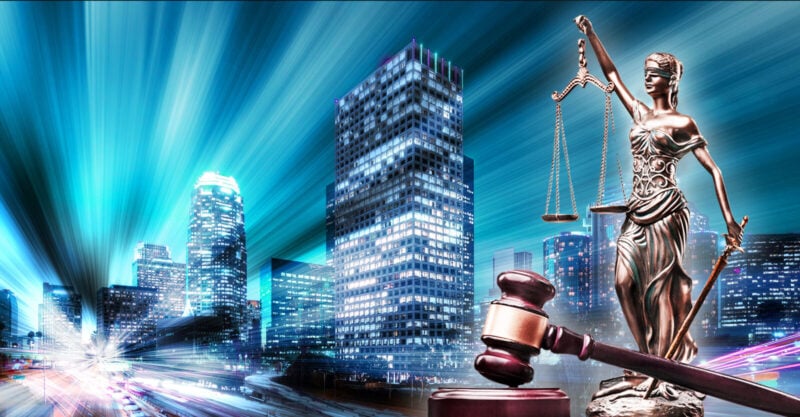‘Historic Day’: Judge Hears Arguments in CHD Lawsuit Challenging Fast-tracking of 5G Infrastructure in Los Angeles
A Los Angeles County Superior Court judge this week heard oral arguments in a lawsuit brought by Children’s Health Defense and a coalition of community and environmental groups that allege the county’s plan to fast-track wireless infrastructure violates state law.
Miss a day, miss a lot. Subscribe to The Defender's Top News of the Day. It's free.
Roughly 50 people on Tuesday rallied in front of a Los Angeles County courthouse on the opening day of a trial that will determine if the county’s plan for the uncontrolled expansion of wireless infrastructure violates state law.
Children’s Health Defense (CHD) and a coalition of community and environmental groups including Fiber First LA sued Los Angeles County in March 2023 after county officials passed two ordinances allowing telecommunications companies to install wireless infrastructure without environmental review or public input.
Los Angeles County Superior Court Judge James C. Chalfant heard arguments in the case and said he plans to hear more arguments — probably next week — before rendering a decision.
Tuesday’s hearing was a “historic day,” according to Brenda Martinez, a Los Angeles County resident and founding member of Fiber First LA.
Martinez, who also is a fellow with CHD’s Electromagnetic Radiation (EMR) and Wireless program, said at a press conference during the rally that low-income communities like hers are tired of being “used as an excuse” to justify the rollout of wireless infrastructure.
“We’re here representing millions of people in communities impacted by the digital divide,” she said Tuesday.

According to the World Economic Forum, building out the 5G wireless technology will “fix” the digital divide.
But Martinez said she believes closing the digital divide won’t happen by passing ordinances that allow for the fast-tracked proliferation of “inefficient, fire-hazardous and expensive wireless technology,” Martinez said.
This lawsuit is about getting Los Angeles County to listen to its constituents, she said. “We will speak louder and clearer.”
Martinez told The Defender she and others represented in the lawsuit are concerned about how wireless radiation may affect the health of their community members — especially children and the elderly — and the environment.
In addition to CHD and Fiber First LA, plaintiffs in the suit include Mothers of East LA, Boyle Heights Community Partners, United Keetoowah Band of Cherokee Indians in Oklahoma, Union Binacional de Organizaciones de Trabajadores Mexicanos Ex Braceros 1942-1964, California Fires & Firefighters, Malibu For Safe Tech, EMF Safety Network, California for Safe Technology and 5G Free California.
Judge hears some claims, saves others for future hearing
The judge split the case’s arguments into two hearings, said W. Scott McCollough, attorney for the plaintiffs and lead litigator for CHD’s EMR cases.
The plaintiffs were able to argue many of their key claims in this week’s hearing, including that the county’s “ministerial review” process for wireless project applications is little more than a “closed-door rubber stamping” process devoid of the public’s input, McCollough told The Defender.
“The people who are impacted get no notice, they have no opportunity to object or even propose changes,” he said.
The plaintiffs will argue its other claims — including that the county’s ordinances violate the California Environmental Quality Act (CEQA) by exempting projects under the ordinances from CEQA review — at the next hearing, which has yet to be officially scheduled.
‘We got a fair hearing’
The judge listened well while both sides presented their arguments and was clearly knowledgeable, McCollough said.
“He read the brief. He read all the cases and all the rules we cited — and so no matter how it turns out, all I can say is the guy did his homework and we got a fair hearing.”
Mitchell M. Tsai, attorney for the plaintiffs, said in a press conference after the hearing that he was “cautiously optimistic.”
McCollough agreed. The judge’s statements and questions suggested he “seems inclined to rule that most of the state law issues we are raising are not preempted by federal law,” McCollough said.
Fiber First LA member Julie Levine, who attended the hearing, said the judge pointed out that the county has the ability — and the responsibility — to have protective ordinances within what is allowable by the Federal Communications Commission (FCC).
“In fact,” Levine told The Defender, “the FCC encourages local municipalities to have their own ordinances to guide things like placement of these [wireless] towers.”
This undermines Los Angeles County’s claim, “Oh, we can’t do anything because the federal government prohibits it,” she said.
McCollough cautioned that judges sometimes play devil’s advocate during hearings to test their own theory on a matter, making it impossible to predict how the judge will rule.
Wireless issue is ‘gaining traction’
People attending the rally carried signs bearing slogans including, “Board of supervisors gagged the public’s voice” and “What if a cell tower goes up in front of your home with no notice or hearing?”

Sarah Aminoff, a Fiber First LA member who attended the hearing and rally, told The Defender she found it “shocking” that Los Angeles County did away with environmental review and giving notice to local residents for proposed wireless projects.
“I was really impressed with the community that was gathered [to support the lawsuit], especially people who had been disproportionately impacted,” Aminoff said.
Levine, who founded the nonprofit 5G Free California, agreed. “This issue is gaining traction.”
La Opinión, a major Los Angeles newspaper for Spanish speakers, covered the rally, according to Martinez, as did two local radio stations: AM870, a Hispanic Republican station, and KPFK 90.7 FM, a “progressive” station, Levine said.
Levine found it interesting that “the Left and the Right” both covered the rally. “I would’ve liked to have seen, of course, mainstream television … but they pretty much have censored out this issue because of, probably, who funds them and sits on their board, the power of Big Tech.”
Levine, who became sick from wireless radiation and had to leave her home of 22 years, spoke at the rally about how she was “constructively evicted from LA County” due to its wireless project policies.
People need to resist the wireless rollout, Levine said. “This is an issue where we can all come together because it impacts every single one of us.”
The 5G agenda is to put wireless towers every 200 to 500 feet across the world, she said. “Not for better cell signal [but] for data collection [and] the Internet of Things — for their profits and our surveillance.”
Sign up for free news and updates from Children’s Health Defense. CHD focuses on legal strategies to defend the health of our children and obtain justice for those injured. We can't do it without your support.
Republishing Guideli


No comments:
Post a Comment